Ben Hutton and Confirmation Bias

6 years ago
It was a rough game on Sunday night.
Even if you think the Canucks played a good game, the final score of 6-1 wasn’t very flattering for the home team. Emotions were running high and the takes were quick and fiery as fans reacted to what was happening in the game.
Which brings me to the first goal that the Flames scored last night. It can be seen in its entirety here:
After this goal, there was a lot of blame placed on Ben Hutton.
I’m not going to throw anyone under the bus here, but there was a lot of suggestions on twitter that he was muscled off the puck, that he misread it, or the “oh, Hutton!” narrative. Hutton has been a lightning rod for criticism this season, as many people feel that he hasn’t been playing well this year, while others have been going to bat for him. (including CanucksArmy’s own Jeremy Davis writing a novel about it)
Whenever I see a reactionary negative comment about any player – I immediately think of confirmation bias. Which in case you don’t know is:
Confirmation bias, also called confirmatory bias or myside bias, is the tendency to search for, interpret, favor, and recall information in a way that confirms one’s preexisting beliefs or hypotheses.
We are all guilty of it. Our brains, based on what we already know and believe, will automatically take the easier route to reach a conclusion. In this context, the Canucks get scored on, Ben Hutton was the last Canuck to touch the puck and he was in clear view of Jankowski scoring. Thus because of some preconceived biases, it’s easier for some of us to conclude that it was Hutton’s fault.
The key is to look past what you automatically think and try to look at something objectively. So, let’s break down the play:
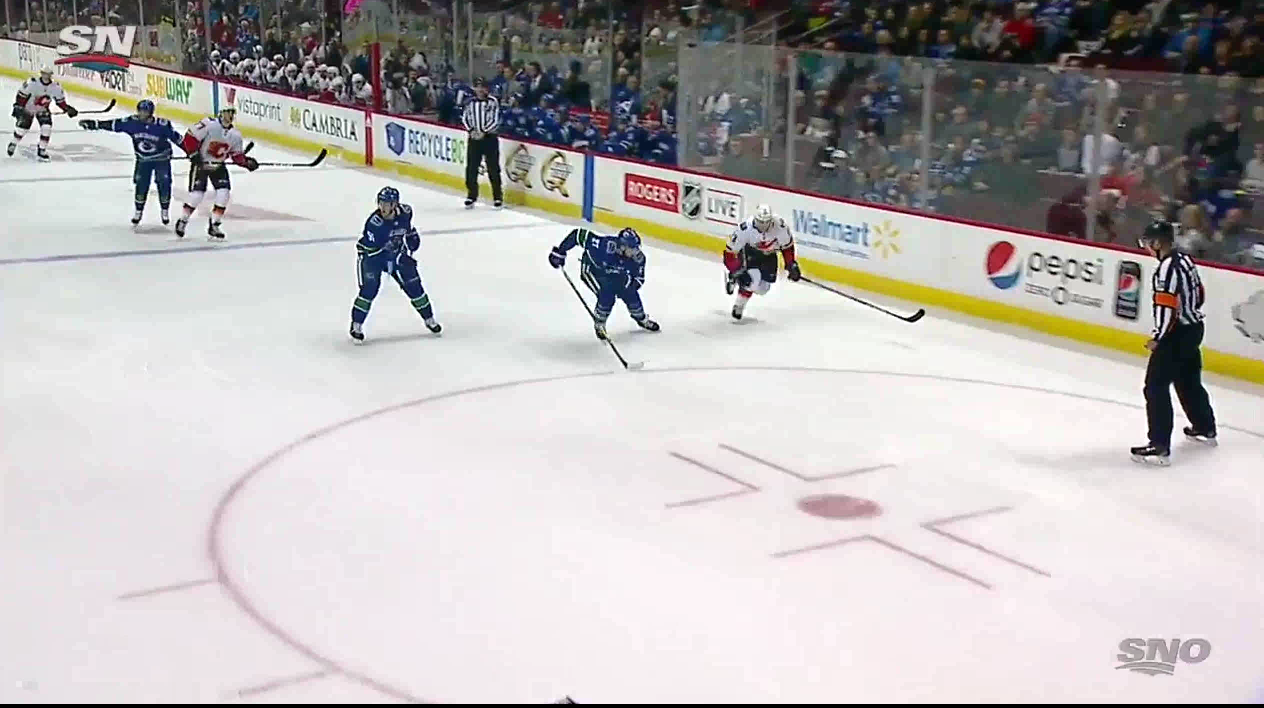
Hutton is engaged in a race with Garnet Hathaway on his off-side. His partner at the moment, Troy Stecher, is on his inside and is covering that side as Hutton/Hathaway race down the ice. Alex Burmistrov is just outside the zone, pointing to Nikolay Goldobin to cover the far boards, I’d assume in case the puck goes there. Jake Virtanen is just outside the frame on the left, cruising towards his side.

Hutton wins the engagement by lifting the stick of Hathaway. Stecher has moved into the zone on the right side of Jacob Markstrom. Virtanen’s legs have come into the picture, while Burmistrov is coming into the high slot. Everything is going well here.
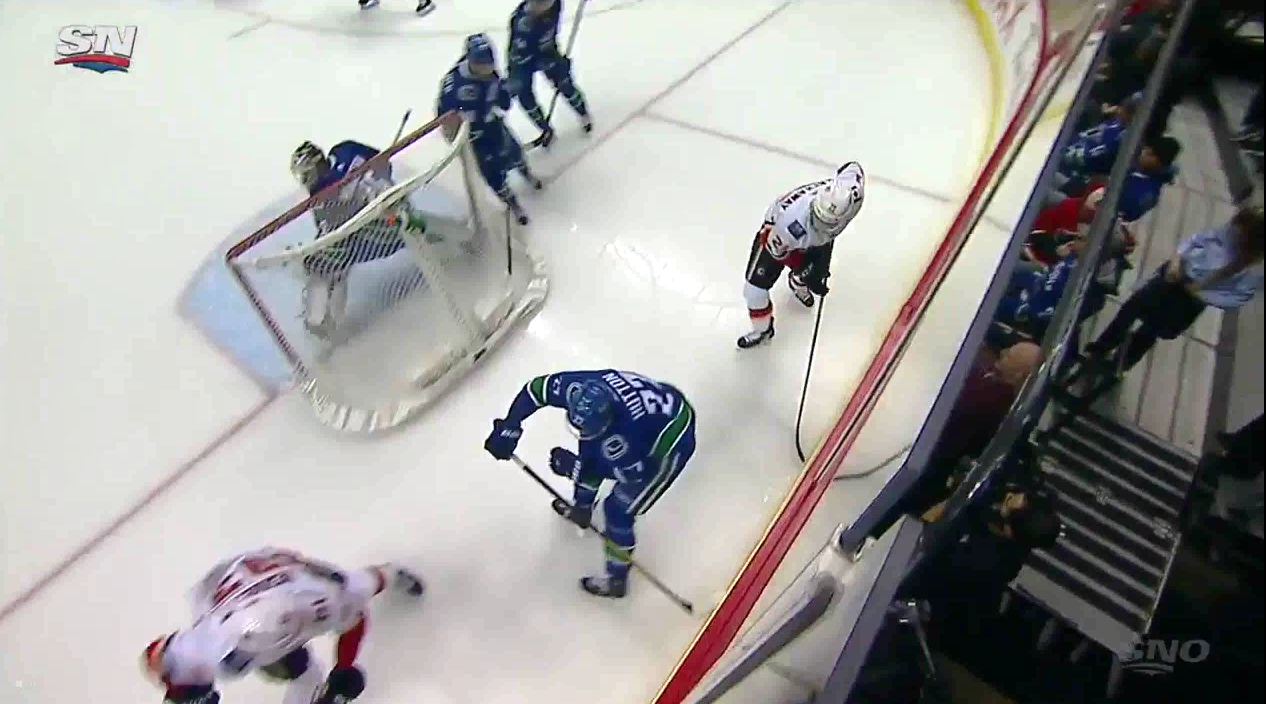
A wild Sam Bennett appears!
Hutton is able to chip the puck past Bennett and into the corner. Despite checking one player, and getting the puck past another forechecker, there were some suggestions that Hutton was outmuscled on the puck. On the flip side, it’s correct to say that Hutton was able to win a puck race and then get the puck away from a 2-1 on engagement behind the net.
Important to add that Stecher has lowered his position because of the two players, while Virtanen his looping behind the net – away from his side.
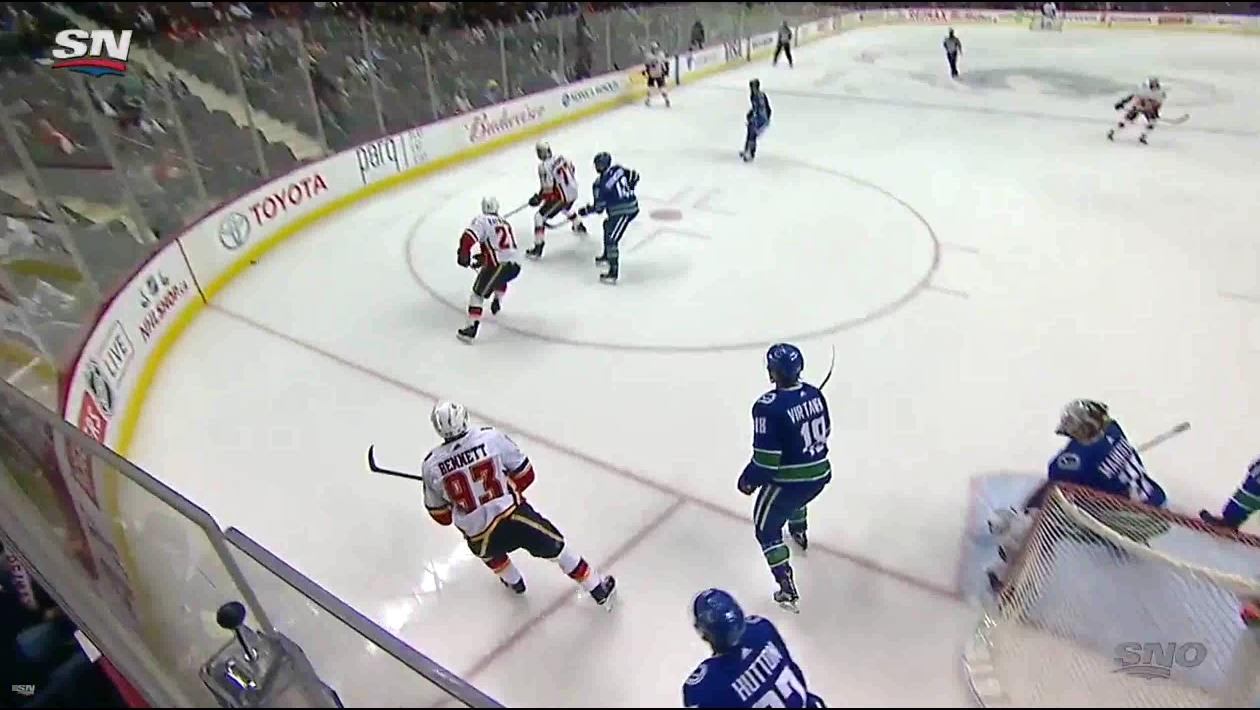
The puck has moved into the open corner – Burmistrov has recognized the danger but is behind Jankowski. Hathaway cut between the Bennett/Hutton engagement and is ahead of Virtanen. Bennett still is on that side after stopping Hutton. Goldobin sees the Flames defenceman and is covering that area, in case the puck goes up.
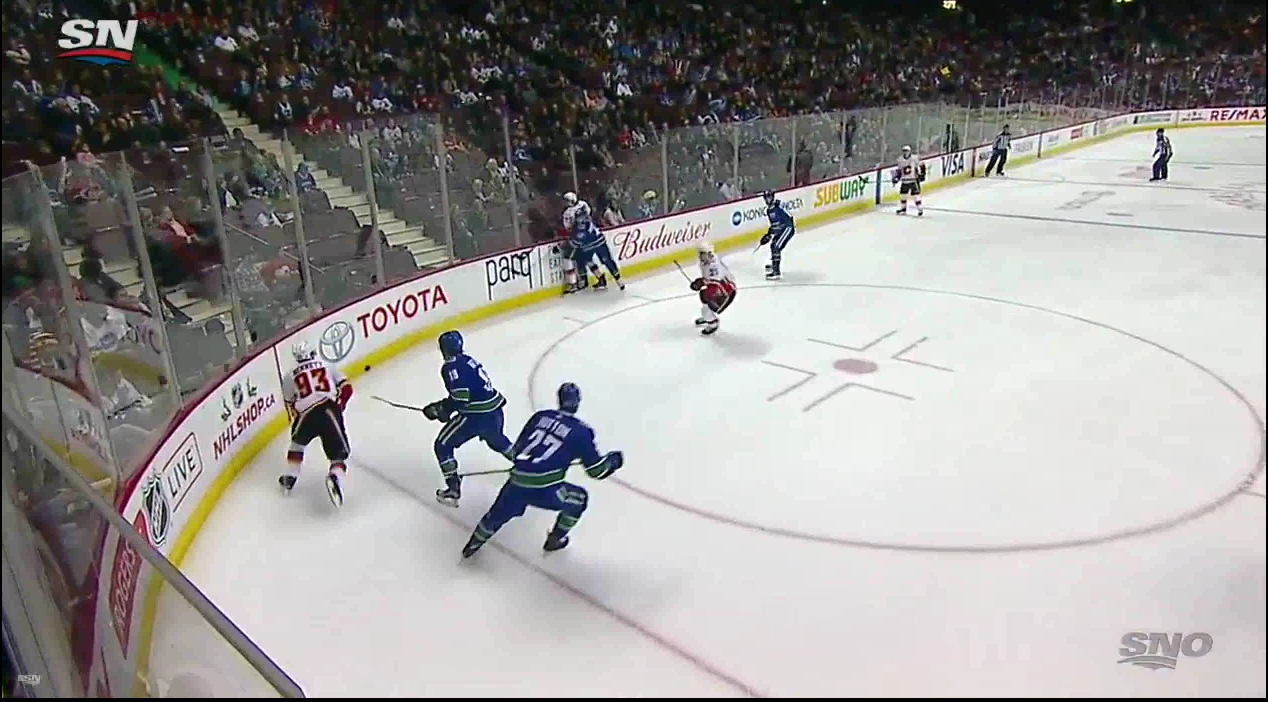
Jankowski decides to go low to Bennett, with Hathaway looping back with the puck. Everything is still fine as Hutton has started to peel off to cover the left side of the night. Stecher is still covering the right side but has started to move more into the front.
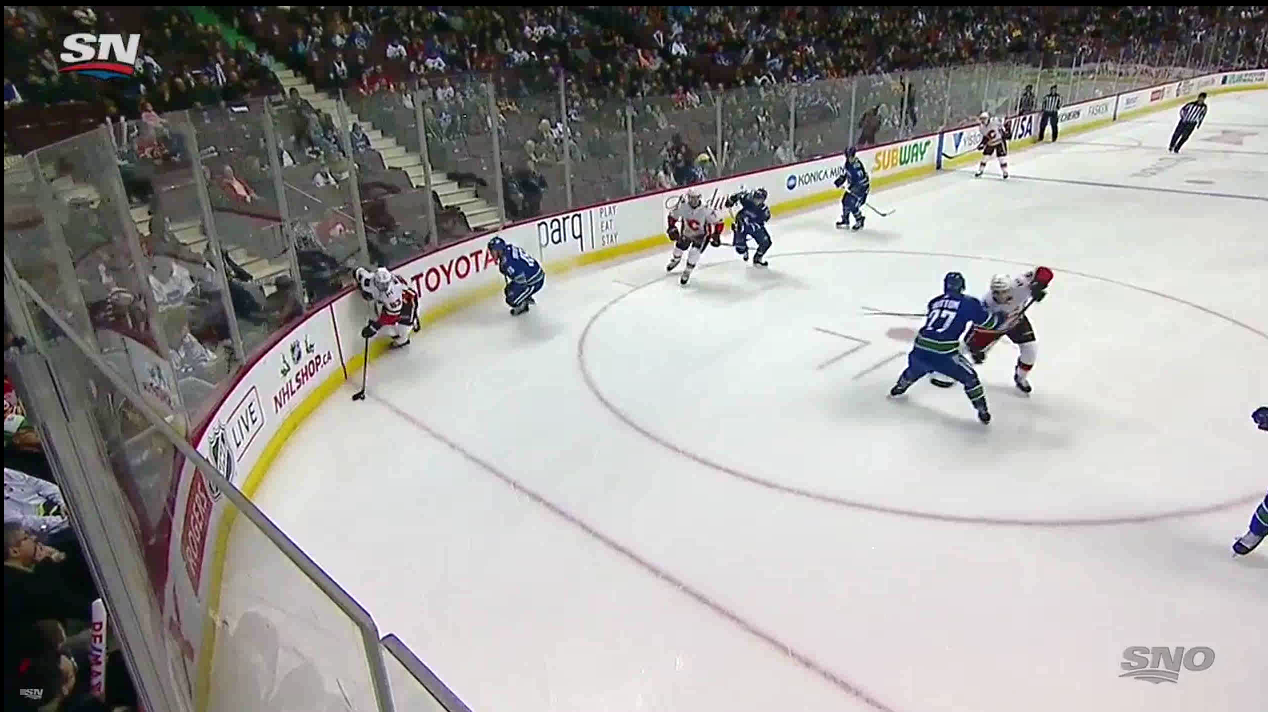
Things have quickly turned.
Bennett quickly pivoted, losing Virtanen as he did not engage on the boards in time. Jankowski has the inside lane on Burmistrov, despite the Canucks forward closing him into the boards. Hathaway has correctly attacked the net, forcing Hutton to try and stop him. The suggestion that Hutton was outmuscled may also apply here, but Hathaway actually tucks his shoulder to slip past Hutton. Completely missing a physical engagement where Hutton would be ‘overpowered’.

The last screen grab before the goal – Bennett has made a pass to Jankowski. Not seen fully here, but Hathaway has his stick under Hutton’s hand and had lifted the Canucks defender’s stick to create the passing lane. This is all despite having Stecher engaging him. Jankowski has the inside track on Burmistrov and puts it into the far bottom corner.
As objectively as possible – here is how I see the goal.
- Hutton won a puck race/battle, was engaged by another forechecker.
- Two Canucks were beat to the puck in the corner
- Virtanen and Burmistrov were unable to slow down or contain their checks.
- Bennett had a smart pivot to get space, Jankowski read that Bennett was free and went to the net
- Burmistrov was beaten to the net by Jankowski
- Hutton didn’t stop Hathaway from getting past him
- Hathaway lifted Hutton’s stick as he was trying to cover the passing lane to the front.
It’s clear that Hutton wasn’t 100% scot-free in this play, but isn’t to blame. He made the correct play behind the net by lifting the stick of Hathaway, taking the puck and chipping it to an open space behind Bennett. He reacted to the corner play and then got stuck in no man’s land while having his stick lifted right as the puck went through the lane that he was attempting to cover.
If anything, the two forwards were more at fault for this goal, as they failed to keep contain or adjust their checks paths. It’s also not simply, they got beat to the puck in the corner, so it’s their fault. Based on how the play developed, them being first to puck (in both cases) was almost impossible. It’s a collection of breakdowns.
This also isn’t to say that Hutton wasn’t to be blamed for other miscues later in the game, or in the future.
How this loops back to confirmation bias is that you can point the finger at any of those three, Hutton, Virtanen, or Burmistrov, and easily find blame. Whether you are willing to admit it or not – we all have pre-conceived dislikes for the player, and thus any play that does end up in the back of the net, it’s easier to point to said player.
More often then not, it’s a combination of factors that lead to a goal against – a system breakdown, a great read by the opposition, bad luck, or not adapting quick enough.
Twitter is the perfect forum for this bias to shine – it’s a platform that allows for reactionary thoughts to be thrown out. Thinking about something too long can mean you are late to the party. But taking a moment and watching the replay can go a long way to overcoming that bias and objectively analyzing what players are.





